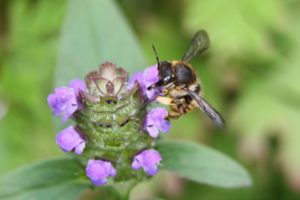Flowers that attract Wool carder bees
Wool carder bees, (Anthidium manicatum) are fascinating to watch. To encourage them into your wildlife garden plant these flowers, grab a brew and watch their fast and furious lives!
This is a small selection of flowers that they use for nest material (hairs) and nectar. The males in particular nectar frequently to fuel their very busy life patrolling and protecting areas of forage flowers. If they are large and strong enough, they will drive away the competition (including other insects!) and establish prime forage areas for themselves and of course, females.
They get their name from the females behaviour of scrapping and cutting hairs (carding), from plant stems or leaves using their mandibles. They roll them up into a ball and carry it underneath their abdomen back to their chosen nest site. They do not use leaves or mud as do other megachilid bees.
Although the females will use the hairs from Orange hawkweed, (Pilosella aurantiaca) and other plants, a very popular plant in the UK used by them for nest building is Lamb’s ear, Stachys byzantina. It is much hairier than most other plants.
The author and Guardian writer, Kate Bradbury wrote a lovely article about these bees and this plant. Like her, I find them fascinating as I watch them live out their frantic, fast and furious lives, especially the males.
“All my articles and videos, available free, are funded by my teaching, presentations, sales of award-winning bumblebee nest boxes, solitary bee boxes, and wormeries. Please help by spreading the word and forwarding this link to your friends and colleagues. https://nurturing-nature.co.uk Thank you” George Pilkington
Download a BWARS Information Sheet about wool carder bees
More information about Wool carder bees
For info and link to buy an excellent book Field Guide to the Bees of Great Britain and Ireland by Steven Falk
An extremely useful resource supports this book by a special website feature within Steve Falk’s Flickr website which furnishes extra photos and other useful resources to assist with identification.
Solitary Bees book by Ted Benton
Interested in Citizen Science and pollinators? The Buzz Club


Recent Comments